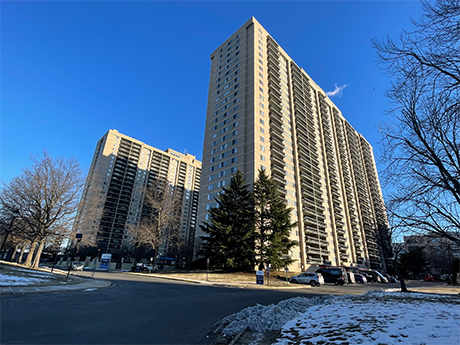The editors of REBusinessOnline.com are conducting a brief online survey to gauge market conditions in 2026, and we welcome your participation. The survey should only take a few minutes to complete. Questions range from property sectors that you are most bullish on heading into 2026 to trends in deal volume to your outlook for interest rates. The results of our 15th annual survey will be compiled and published in the January issues of our regional magazines. Conducting these surveys is part of our mission at France Media to provide readers with indispensable information, and we couldn’t do it without your help. To participate in our broker/agent survey, click here. To participate in our developer/owner/manager survey, click here. To participate in our lender/financial intermediary survey, click here. (Note: Please remember to click on “done” to properly submit the survey.)
Texas & Oklahoma Feature Archive
FeaturesHeartland Feature ArchiveNortheast Feature ArchiveSoutheast Feature ArchiveTexas & Oklahoma Feature ArchiveWestern Feature Archive
Affordable HousingDistrict of ColumbiaFeaturesHeartland Feature ArchiveMultifamilyMultifamily & Affordable Housing Feature ArchiveNortheast Feature ArchiveSoutheastSoutheast Feature ArchiveTexas & Oklahoma Feature ArchiveWestern Feature Archive
Why Fannie Mae, Freddie Mac Believe the Wind Is at Their Back
by John Nelson
Fannie Mae and Freddie Mac are adopting a more pro-business approach when it comes to closing multifamily loans in 2025 than in recent years, when sources say they were more selective. The two government-sponsored enterprises (GSEs) combined to produce 33 percent more multifamily loans in first-quarter 2025 compared with first-quarter 2024. “There is definitely a ‘volume on’ mindset at both shops,” says Landon Litty, director of agency sales at BWE. “This is a real positive for borrowers.” For Fannie Mae, the volume of multifamily loans totaled $11.8 billion in the first quarter of 2025, compared with $10.1 billion in the first quarter of 2024. Meanwhile, Freddie Mac produced approximately $15 billion in multifamily loans in the first quarter, financing around 144,000 rental units, well above the approximately $10 billion produced in first-quarter 2024. “The first quarter of 2025 has been dynamic, with real-time adjustments to meet market needs while maintaining a focus on soundness,” says a spokesperson at Freddie Mac Multifamily. Other sources attest that the GSEs are focusing on their sponsors more so than in previous years. T.J. Edwards, chief production officer for the multifamily finance division at Walker & Dunlop, says the agencies are proactively vetting first-time borrowers …
InterFace: Today’s Successful Student Housing Developments Pair Great Site Selection with Efficient Design
by John Nelson
AUSTIN, TEXAS — It’s no secret that finding and entitling sites and procuring development financing has been challenging over the past few years. But Kevin Kazlow, director of capital markets with JLL, who moderated one of the development panels at this year’s InterFace Student Housing conference in Austin, Texas, believes there is lots to be excited about for the year ahead. Chief among them is the fact that the amount of capital allocated to alternative asset classes like student housing has doubled since 2018. “This group of panelists alone has a combined pipeline of about 40,000 beds under development, which is an incredibly impressive statistic and speaks to the continued demand for new student housing projects,” said Kazlow. Editor’s note: InterFace Conference Group, a division of France Media Inc., produces networking and educational conferences for commercial real estate executives. To sign up for email announcements about specific events, visit www.interfaceconferencegroup.com/subscribe. The first step in the development process is securing a great site, which Brandt Stiles, principal with Subtext, considers part of his firm’s ‘secret sauce.’ “We have a really high expectation for our team to find super high barrier to entry, hard to entitle, fortress sites and for us, it’s all about being …
DALLAS — The evolution of active adult product is in the third inning of a nine-inning game, but some markets are clearly ahead of the curve, says Zach Crowe, managing director of U.S. real estate for private equity giant The Carlyle Group. “There are markets like Dallas, Las Vegas and Denver that have had active adult for 20 years at this point, and the product is well known. The consumer understands what it is. There are other markets with very few properties, and people have no idea what it is. It’s still incredibly early [in the game],” reports Crowe, who is based in Washington, D.C., and focuses on real estate investment opportunities in multifamily, 55+ housing and medical office properties. Editor’s note: InterFace Conference Group, a division of France Media Inc., produces networking and educational conferences for commercial real estate executives. To sign up for email announcements about specific events, visit www.interfaceconferencegroup.com/subscribe. The insights from Crowe came during the CEO panel at the fifth annual InterFace Active Adult conference. The daylong conference, which took place May 7 at The Westin Los Colinas in Dallas, attracted more than 300 industry professionals. Moderated by Ryan Maconachy, vice chairman of health and alternative assets for Newmark, the …
FeaturesHeartland Feature ArchiveMultifamily & Affordable Housing Feature ArchiveNortheast Feature ArchiveSoutheast Feature ArchiveTexas & Oklahoma Feature ArchiveWestern Feature Archive
Forecast Survey: What’s Your Take on Commercial Real Estate in 2025?
by John Nelson
The editors of REBusinessOnline.com are conducting a brief online survey to gauge market conditions in 2025, and we welcome your participation. The survey should only take a few minutes to complete. Questions range from property sectors that you are most bullish on heading into 2025 to trends in deal volume to your outlook for interest rates. The results of our 14th annual survey will be compiled and published in the January issues of our regional magazines. Conducting these surveys is part of our mission at France Media to provide readers with indispensable information, and we couldn’t do it without your help. To participate in our broker/agent survey, click here. To participate in our developer/owner/manager survey, click here. To participate in our lender/financial intermediary survey, click here. (Note: Please remember to click on “done” to properly submit the survey.)
AUSTIN, TEXAS — It’s no secret that today’s commercial real estate market can be challenging, whether you’re looking to break ground on a new project or close a transaction. But there’s plenty to be optimistic about in the student housing sector moving forward, according to Peter Katz, executive managing director of Institutional Property Advisors. Katz moderated this year’s “Power Panel,” which kicked off the first full day of the 16th annual InterFace Student Housing conference, held at the JW Marriott in Austin. The panel brought together a consortium of high-level executives to provide their thoughts on the current dynamics in the sector and their outlook for the year ahead. “I always feel the energy and the excitement in the student housing sector,” began Katz. “And while we feel a sense of tempered exuberance this year, the investment community is still extremely enthusiastic. Consumer strength is coming in hotter than expected and inflationary readings are pushing out the timing of proposed interest rate cuts from The Fed.” Two years into the cycle of tightening from The Fed, investors are recognizing that the price adjustments that have already occurred have now become an acquisition opportunity, Katz continued. “And while there’s still pain …
FeaturesHeartland Feature ArchiveMultifamily & Affordable Housing Feature ArchiveNortheast Feature ArchiveSoutheast Feature ArchiveTexas & Oklahoma Feature ArchiveWestern Feature Archive
Forecast Survey: What’s Your Take on Commercial Real Estate in 2024?
by John Nelson
The editors of REBusinessOnline.com are conducting a brief online survey to gauge market conditions in 2024, and we welcome your participation. The survey should only take a few minutes to complete. Questions range from property sectors that you are most bullish on heading into 2024 to trends in deal volume to your outlook for interest rates. The results of our 13th annual survey will be compiled and published in the January issues of our regional magazines. Conducting these surveys is part of our mission at France Media to provide readers with indispensable information, and we couldn’t do it without your help. To participate in our broker/agent survey, click here. To participate in our developer/owner/manager survey, click here. To participate in our lender/financial intermediary survey, click here. (Note: Please remember to click on “done” to properly submit the survey.)
FeaturesHeartland Feature ArchiveNortheast Feature ArchiveOtherSoutheast Feature ArchiveTexas & Oklahoma Feature ArchiveWestern Feature Archive
Forecast Survey: What’s Your Take on Commercial Real Estate in 2023?
by John Nelson
The editors of REBusinessOnline.com are conducting a brief online survey to gauge market conditions in 2023, and we welcome your participation. The survey should only take a few minutes to complete. Questions range from property sectors that you are most bullish on heading into 2023 to trends in deal volume to your outlook for interest rates. The results of our 12th annual survey will be collated and published in the January issues of our regional magazines. Conducting these surveys is part of our mission at France Media to provide readers with indispensable information, and we couldn’t do it without your help. To participate in our broker/agent survey, click here. To participate in our developer/owner/manager survey, click here. To participate in our lender/financial intermediary survey, click here. (Note: Please remember to click on “done” to properly submit the survey.)
Three Keys for Shopping Center Owners to Remember When Protesting Property Tax Assessments
by John Nelson
Property owners should receive a Notice of Appraised Value from their appraisal district by mid-April. This year, it is imperative that retail property owners submit an assessment protest prior to the deadline and help to establish fair taxable valuations in the post-pandemic marketplace. Since March 2020, COVID-19 has brought uncertainty and ongoing challenges to real estate owners. People often discuss the commercial real estate “winners and losers” of COVID-19, and of the four commercial real estate food groups, retail certainly suffered one of the heaviest initial blows. But how has the property type recovered as the pandemic has evolved? This article explores where exactly retail falls, and then offers strategies to argue more effectively for reduced assessments. Evolving trends To develop a full picture of the current state of shopping centers, one must look back to 2019 and early 2020 before the pandemic. In 2018, approximately 5,800 retail stores closed nationwide and only 3,200 opened, for an overall deficit of 2,600 locations. In 2019, the size of the annual store deficit nearly doubled with 5,000 more closures than openings. E-commerce sales volume rose steadily from 2010 through 2019, which, coupled with accelerating physical store closures, clearly indicate a slowdown in …
Company NewsFeaturesHeartland Feature ArchiveHospitalityIndustrialMixed-UseMultifamilyNortheast Feature ArchiveOfficeRetailSoutheast Feature ArchiveTexas & Oklahoma Feature ArchiveWestern Feature Archive
Forecast Survey: What’s Your Take on Commercial Real Estate in 2022?
by John Nelson
The editors of REBusinessOnline.com are conducting a brief online survey to gauge market conditions in 2022, and we welcome your participation. The survey should only take a few minutes to complete. Questions range from property sectors that you are most bullish on heading into 2022 to trends in deal volume to your outlook for interest rates. The results of our 11th annual survey will be collated and published in the January issues of our regional magazines. Conducting these surveys is part of our mission at France Media to provide readers with indispensable information, and we couldn’t do it without your help. To participate in our broker/agent survey, click here. To participate in our developer/owner/manager survey, click here. To participate in our lender/financial intermediary survey, click here. (Note: Please remember to click on “done” to properly submit the survey.)
Newer Posts











